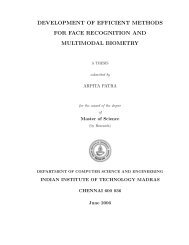The Enigma of Group Theory - Department of Computer Science ...
The Enigma of Group Theory - Department of Computer Science ...
The Enigma of Group Theory - Department of Computer Science ...
You also want an ePaper? Increase the reach of your titles
YUMPU automatically turns print PDFs into web optimized ePapers that Google loves.
http://www.cs.bris.ac.uk University <strong>of</strong> Bristol, <strong>Department</strong> <strong>of</strong> <strong>Computer</strong> <strong>Science</strong><br />
Machines in use towards the end <strong>of</strong> the war had a larger number <strong>of</strong> rotors, chosen from a larger set.<br />
Note, the order <strong>of</strong> the rotors in the machine is important, so the number <strong>of</strong> ways <strong>of</strong> choosing the rotors is<br />
5 · 4 · 3 = 60.<br />
Each rotor had an initial starting position, and since there are 26 possible starting positions for each rotor,<br />
the total number <strong>of</strong> possible starting positions is 26 3 = 17 576.<br />
<strong>The</strong> first rotor would step on the second rotor on each full iteration under the control <strong>of</strong> a ring hitting<br />
a notch, likewise the stepping <strong>of</strong> the third rotor was controlled by the second rotor. Both the rings were<br />
movable and their positions again formed part <strong>of</strong> the key, although only the notch and ring positions<br />
for the first two rotors were important. Hence, the number <strong>of</strong> ring positions was 26 2 = 676. <strong>The</strong> second<br />
rotor also had a kick associated to it making the cycle length <strong>of</strong> the three rotors equal to<br />
26 · 25 · 26 = 16 900.<br />
<strong>The</strong> effect <strong>of</strong> the moving rotors was that a given plaintext letter would encrypt to a different ciphertext<br />
letter on each press <strong>of</strong> the keyboard. Finally, a plug board was used to swap letters twice in each<br />
encryption and decryption operation. This increased the complexity and gave another possible 10 14<br />
keys.<br />
<strong>The</strong> rotors used, their order, their starting positions, the ring positions and the plug board settings<br />
all made up the secret key. Hence, the total number <strong>of</strong> keys was then around 2 75 .<br />
To make sure encryption and decryption were the same operation the message letter was passed<br />
through the plug board, then through the three rotors, and then through another fixed substitution<br />
called the reflector. After passing through the reflector the message letter was sent back through the<br />
three rotors and the plugboard again. <strong>The</strong> reflector was fixed in the machine, and was given by<br />
ABCDEFGHIJKLMNOPQRSTUVWXYZ<br />
YRUHQSLDPXNGOKMIEBFZCWVJAT<br />
<strong>The</strong> operation <strong>of</strong> a simplified <strong>Enigma</strong> machine is described in Fig. 1. By tracing the red lines one<br />
can see how the plaintext character A encrypts to the ciphertext character D. Notice that encryption and<br />
decryption can be performed by the machine being in the same positions. Now assume that rotor one<br />
moves on one step, so A now maps to D under rotor one, B to A, C to C and D to B. You should work<br />
out what happens with the example when we encrypt A again.<br />
A<br />
B<br />
C<br />
D<br />
Figure 1: Simplified <strong>Enigma</strong> machine<br />
Three rotors<br />
LampsKeyboardPlugs<br />
1 2 3 Reflector<br />
A<br />
B<br />
C<br />
D<br />
❏ ❏✡ ✡<br />
❇<br />
✡<br />
❇<br />
❇<br />
✡<br />
✡ ❏✂ ❏<br />
❏<br />
✂<br />
❏✡ ✂❏<br />
❏✡<br />
<strong>The</strong> purpose <strong>of</strong> this note is to present a mathematical model <strong>of</strong> the <strong>Enigma</strong> machine and show how<br />
some basic facts about permutations allowed the Polish cryptographers to break the cipher.<br />
1 Permutations<br />
We want to find a mathematical description <strong>of</strong> the <strong>Enigma</strong> machine. To do this we will first need to<br />
introduce the concept <strong>of</strong> a permutation [?].<br />
We let A be a finite set <strong>of</strong> size n, we might as well assume that the set is given by A = {1, 2, . . . , n}. A<br />
function from A to A is said to be one-to-one if every element in A maps to exactly one element in A; for<br />
example if A = {1, 2, 3}, then we have the one-to-one function f (1) = 2, f (2) = 3 and f (3) = 1. Another<br />
name for such one-to-one functions from A to A is a permutation, since such a function permutes the<br />
elements in the set around.<br />
4










